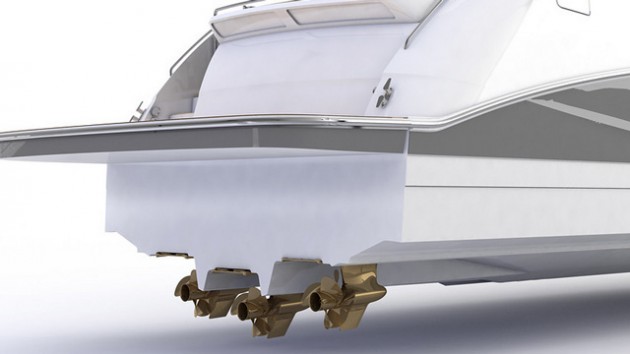Marine Engines and Power Systems: The Basics Behind What Powers Your Powerboat
Outboard engines, inboards, pod drives, jets, V drives, diesel, and gas—we’ll help you understand all the types of motorboat engines on the water.
Boat engines take many shapes, sizes, and forms, ranging from the common outboard to rarely seen surface drive systems—which is why you’ll find plenty of current information on the latest and the greatest in our powerboat Reviews, Engines, and Parts library. But sorting through all of the different options can be quite difficult. Which is best for the type of boating you enjoy? Is newer technology necessarily better? And which engine and drive systems are evolving the fastest? Let’s take an in-depth look at motorboat engines and power systems.
Strictly speaking, the engine is what creates power and the drive system is what transfers that power into thrust. So logically, you want to distinguish between the two. There’s just one problem: many power and drive systems are integrated. The term “outboard engine,” for example, commonly describes both the powerhead and the lower-unit drive system that's attached to it. On the other hand, a “jet engine” comes in both outboard and inboard varieties. So let’s start off by dividing engines and power systems into their most basic forms: outboards and inboards.
Outboard Engine
An outboard engine sits on the transom of a boat and has its own self-contained drive system. The powerhead (or motor, in the case of an electric outboard) is protected by a removable cowl. A motor mount just below the powerhead bolts or clamps onto the transom of the boat, and the midsection of the outboard, which encloses the drive shaft and exhaust housing, has a lower unit bolted onto the bottom. Most of the time the lower unit swings a propeller for propulsion, but in some cases the lower unit houses a jet drive. A lower units with a propeller also incorporate a skeg, which offers it some protection from striking hard objects.

All outboard engines, including this Yamaha F115, share the same basic design. Image credit: Boats.com
Outboard engines boast a long list of advantages. They generally have an excellent power-to-weight ratio; they’re essentially portable (especially smaller models) and can be easily replaced; they can be tilted to remove the drive system from the water; handling is excellent since the entire system articulates as one; outboards don’t take up room on the inside of the boat; many are designed from the ground up for marine use (as opposed to being automotive engines that are marinized); their cooling systems self-drain for easy winter storage; and in many cases they’re less expensive than other options.
A huge range of sizes is available, from small electric models which produce a fraction of a horsepower and are powered by a 12-volt battery, all the way up to the largest currently offered, a semi-custom Seven Marine 627 HP outboard. Between all those different choices, it’s possible to power everything from a canoe to a 50’ center console with outboard engines. Outboards are also used by sailors, as auxiliary power. And in some cases inboard boats also have an outboard “kicker” motor that is used for extended slow-speed operation (such as trolling for fish) and/or get-home power in case the main powerplant breaks down.
What about the poor reliability, awful pollution controls, and high noise and vibration levels that older salts may associate with outboard engines? It’s ancient history. Stricter EPA rules and regulations forced outboard manufacturers to either shift to four-strokes or redesign cleaner, more efficient two-strokes years ago. And yes, today’s two-strokes really are far more efficient, reliable, and environmentally friendly than old-tech two-strokes (Read DFI Direct Fuel Injection Two Stroke Outboards, to see how modern low-emissions two-strokes work). Today, virtually every outboard on the market not only offers excellent reliability, but also has vastly improved efficiency and is far more pleasurable to run.
Naturally, there are some downsides associated with outboard engines. In some classes of boats, they aren’t quite as efficient as inboards with stern-drive propulsion systems. Take for example the Sea Ray 240 Sundeck, which we tested with both a Mercury 350 MAG stern drive (inboard) and a 300 HP Verado outboard. At a 35 MPH cruise, the stern drive boat got 3.4 miles per gallon (MPG). The outboard powered boat got only 3.1 MPG. Note that the outboard boat went 10 MPH faster at wide-open throttle, but matched at an equal speed, the stern drive proved more efficient. Another downside to having an outboard is the fact that you can’t have a full-beam swim platform. At best, you can have two small platforms, one to either side of the engine, and on many watersports boats this is a significant disadvantage. Finally, when it comes to large, heavy boats, at some point outboards simply aren’t an option. Even the biggest outboards aren’t large enough, for example, to power a 60’ motorboat.
Read reviews and watch videos of specific modern gasoline-powered outboard models from:
Evinrude
- The Outboard Expert: New Evinrude E-TEC 15 HO
- The Outboard Expert: 2009 Models from Evinrude (covering the introduction of 25, 30, 115, and 130 HP models of the first-generation E-TEC engines introduced in 2008 and 2009)
- The Outboard Expert: Evinrude Adds High-Perf 250 Outboard (first generation E-TEC)
- E-TEC G2 250 HP Outboard Test Run (second generation E-TEC introduced in 2014)
- The Outboard Expert: BRP Goes Big with Evinrude E-TEC 300 (first generation E-TEC)
- E-TEC G2 300 HP Outboard: On Water Test Run (second generation E-TEC)
Honda
- The Outboard Expert: Frisky New 40 from Honda
- The Outboard Expert: Deep Inside Honda’s New BF90
- The Outboard Expert: New Honda BF100 Outboard is on the Way
Mercury
- The Outboard Expert: Mercury Marine EFI 25/30 Outboard Under the Microscope
- Mercury Debuts All-New 75 HP, 90 HP, and 115 HP FourStroke Outboards
- Mercury Sea Pro Outboards: The Outboard Expert (commercial-grade 2.1 and 3.0 liter models)
- New Mercury 150 FourStroke Outboard Debuts
- Mercury 150 Four Stroke Outboard Video: First Look
- Verado 5.0 On the Way from Mercury Marine (Verado technical update, 2015)
- The Outboard Expert: Mercury Unveils Two New Verado Models (200 HP, 300 HP models)
- Mercury Verado 350 Video: First Look at a New Outboard
- Mercury Marine Reveals Verado 350, Mercury Racing Verado 400R at Miami Boat Show
- Mercury Racing Verado 400R: Test Run
Seven Marine
- Seven Marine 557 HP Outboards Ready for Production
- Seven Marine 557: Biggest Outboard Engines Sea Trial
- Seven Marine 627 Outboard Debuts at the 2015 Miami Boat Show
Suzuki
- Suzuki DF15A: Long Term Outboard Engine Test
- New Suzuki DF15A and DF20A Offer Easy Starting
- Video: Suzuki 25 and Suzuki 30 Outboards for 2014
- 2015 Suzuki Outboards: News from the Outboard Expert (EFI DF 25A, DF30A, and DF200A technical update)
- Suzuki Beefs Up Mid-Range Outboard Models for 2009 (70, 80, and 90 HP models)
- Suzuki 115 SS Outboard: First Look Video
- The Outboard Expert: Up Close with the New Suzuki DF250 SS Engine
Tohatsu
- The Outboard Expert: More Miami Heat (25 and 30 HP models)
- Hot News from Tohatsu: New 250, 50 HP Outboards
Yamaha
- Yamaha Gets Tough with its F15C and F20 Outboards
- 2010 Yamaha 70, Portable 4-Strokes, and More
- The Outboard Expert: Yamaha Reveals Second-Generation F115 Outboard
- Yamaha F115: First Look Video (second generation 2014 model)
- The Outboard Expert: Yamaha Expands V MAX SHO Outboard Line for 2015 (115, 150, 175 HP models)
- Yamaha F200/VF150: Four Cylinders is Enough
- The New Yamaha Four-Stroke V MAX (200, 225, and 250 HP models)
- The New 4.2-Liter Yamaha Offshore V-6 (225, 250, 300 HP models)
- The Outboard Expert: Exclusive First Drive of Yamaha’s F350
- The Outboard Expert: Yamaha F350 - Meet the New Boss
Electric and Alternative Fuel Outboards
- Alternative Power: Outboards that are Gasoline Free (covers multiple electric and gasoline models, from 1.5 to 80 HP)
- Lehr Propane-Powered 9.9 HP Outboard Motor
- Torqeedo Electric Outboards (4.0R model, approx. 15 HP)
- The Outboard Expert: Mercury Marine and Lehr Outboards Headline the Miami Show (15 HP propane model)
- Lehr 25 Propane Outboard: Don’t Buy Gas – or Propane!
- Evinrude 55 MFE Outboard: Wrong Fuel? Submerged in Water? No Problem.
- Mercury Racing Optimax… Diesel? Yes, Diesel.
- Torqeedo Deep Blue Outboard and Hybrid: Electrifying Power (approx. 80 HP)
Inboard Engines
Simply put, inboard engines are those that reside inside the hull of a boat. But here’s where things often get confusing: straight-shaft drives are commonly just called “inboards” by most people, yet stern drives and pod drives, which are all radically different propulsion systems, are technically also inboards. We’ll address these different drive systems later, but for now, bear in mind that all of them require an engine inside of the boat—so they all count as inboards.
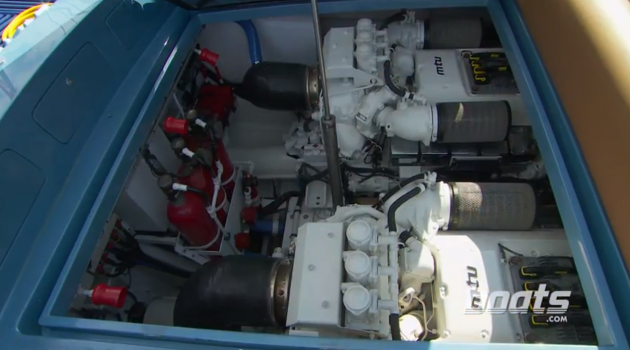
When the engines reside inside of the boat, regardless of which drive system is utilized, the boat is considered an inboard.
When it comes to sheer power, outboards simply can’t match inboards. They’re available in thousands of horsepower; come in both gasoline and diesel models (though when considering the models that out-size the largest outboards, diesel is the only option); and since they can be adapted to mate with many different propulsion systems they work well in a variety of different types of boats.
In some cases, inboards also have an edge when it comes to weight distribution. Many boat designers would argue that having inboards deep in the belly of a boat makes for a lower center of gravity and a better running attitude. That said, all hulls are different and different boats with different power systems can be designed to accommodate different weight distributions.
TIP: As a recreational boater, what’s important for you to remember about this issue is that a boat should be designed specifically for the power system you’re getting with it. In some cases a manufacturer will modify a boat to sell it with inboards when it was originally designed for outboards, or vice-versa. If great care isn’t taken to mitigate the resulting changes in weight distribution, the boat’s running characteristics may be sub-par.
There are, of course, some significant down-sides to inboard engines. Handling is rarely as good as with an outboard (though there are exceptions, most notably inboards paired with pod drives); their power-to-weight ratio isn’t as good as it is with outboards; they’re more difficult to work on and replace; and in many cases they eat up a significant amount of room inside the hull which could otherwise be dedicated to seating, cabin space, or stowage.
Read reviews and watch videos of inboard powerplant models from:
Ilmor
- Small Wonder: Inside the Ilmor MV8 570 Engine
- The Big Picture: Ilmor Marches On
- Ilmor Marine and Mercury Racing Make Power Moves for 2012 (covers Ilmor 570 HP MV8 and Mercury Racing 565)
Indmar
Indmar to Debut First Production Inboard Engine Catalyst at Miami Show
MerCruiser/Mercury
- New Mercruiser 4.5L V6 Promises V8 Performance
- Mercruiser MX 6.2 Black Scorpion Ski Inboard
- MerCruiser Debuts an All New 6.2L V8 Inboard and Sterndrive Marine Engine
- Mercury Racing 540 Replacing 525 EFI
Volvo Penta
- Volvo Penta V8-380 Engine Debuts at Fort Lauderdale
- Volvo Penta Introduces Next Generation V8 and V6 Gasoline Engines
- Volvo Penta to Offer 431 HP Gasoline V8 Engine
Considering the strength and weaknesses of inboards and outboards, it shouldn’t come as much of a surprise that in most classes of boats under 30’ outboards are more popular. (Some exceptions include dedicated wakeboarding or water skiing boats, and some watersports-oriented runabouts). In most classes of motorboats over 40’ inboards rule the roost. And there’s a gray area in-between, where both types of powerplants thrive.
Propulsion Systems
Now that we’ve differentiated between outboards and inboards, we can drill down a bit farther and look at the differences between drive systems. Those for inboards consist of straight-shaft, stern drive, pod drive, V drive, and in rare cases surface drives. Jet drives, you might remember, can be used with both outboards and inboards. Here are the basic characteristics of each:
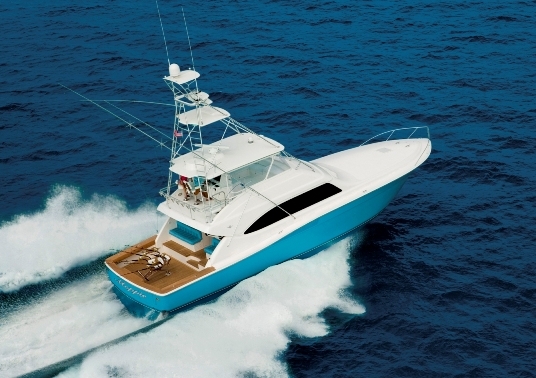
Straight shaft inboards are the norm on large sportfishing boats, like this Bertram 64. Image credit: Bertram
Straight Shafts:
- The shafts come out through the hull-bottom of a motorboat, and steering is accomplished by directing thrust over rudders. That means handling is commonly poor as compared to boats with articulating drives. This deficit is more noticeable at low speed, but can be mitigated if you have twin engines whose fore and aft thrust can be opposed to spin the boat, or with the addition of bow thrusters and/or joystick systems.
- Both gasoline and diesel straight shafts are available, but aside from dedicated water ski and wakeboarding boats (where wake-shaping and locating the propellers as far as possible from people in the water are significant concerns) and a few mid-sized cabin cruisers (where price is a big factor—diesels cost significantly more than gasoline engines), there are relatively few gasoline inboard straight shafts on the market today.
- Straight-shaft boats have relatively deep drafts, and if any of the underwater running gear gets damaged, the boat must be hauled out for repairs.
- The engines in straight-shaft boats are fairly far forward, which can be advantageous when it comes to weight distribution. However, this does tend to eat into cabin space.
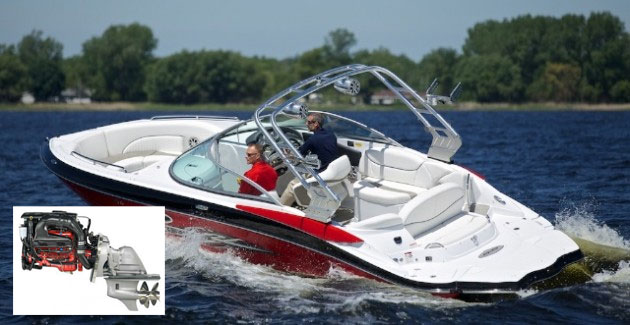
Runabouts often have stern drive propulsion. On this Cruisers bowrider, the engine is located under the aft seat, just forward of the swim platform and transom.
Stern Drives
- The engine is mounted near the transom of the boat and is attached to a drive system that goes through the transom.
- Stern drives offer comparatively good fuel efficiency and good handling, especially at high speeds. At low speed, single-engine stern drives with single propellers (as opposed to DuoProp or Bravo III drives, which have multiple, counter-rotating propellers,) tend to wander and may be difficult to steer.
- Since the drive unit on a stern drive can be trimmed, running angle can be adjusted. At slow speeds, draft can be reduced, and you can bring the prop all the way out of the water when beaching or mooring your boat.
- On a new type of stern drive, the Volvo Penta Forward Drive, the lower unit and propellers face forward (on all other stern drives they face aft). This makes it an attractive option for water skiing and wakeboarding or wake-surfing boats, which have traditionally been straight-shaft inboards, because it moves the propellers forward by over two feet. With the props this far forward and under the boat it seems very unlikely, if not impossible, for a watersports enthusiast to fall into the spinning propellers. See the Forward Drive in action, by watching our Volvo Penta Forward Drive On-Water Test Run.
- Stern drives have an awful lot of moving parts, are fairly complex, and have a well-deserved reputation for requiring more maintenance than most other drive systems.
Read a brand comparison: Stern Drives: Mercruiser Vs Volvo Penta.
Pod Drives
- The newest drive system around, these articulating drives go through the boat’s bottom.
- Compared to straight shafts they usually allow for more cabin space, and compared to stern drives they usually allow for better weight distribution.
- The articulating drives, mounted forward of the transom, offer the very best handling of any type of inboard drive system. They generally come with joystick controls and can spin in their own length or move the boat sideways.
- Pods aren’t an option on smaller boats; very few under 35’ have them and most pod-equipped boats are 40’ or over.
- The drives can’t be trimmed, so draft is always relatively deep and trim tabs are a necessity on most pod-driven boats.
- Pod drives offer an efficiency gain as compared to straight shafts. Many boats net a 15- to 30-percent fuel economy advantage.
Learn more about pod drives by reading All About Pod Drives: Volvo Penta IPS, MerCruiser Cummins Zeus, and ZF Marine.
Read about the newest pod drive to hit the market, the Caterpillar Three60 POD 650, in Pod Drive Update: Cat Enters the Fray.
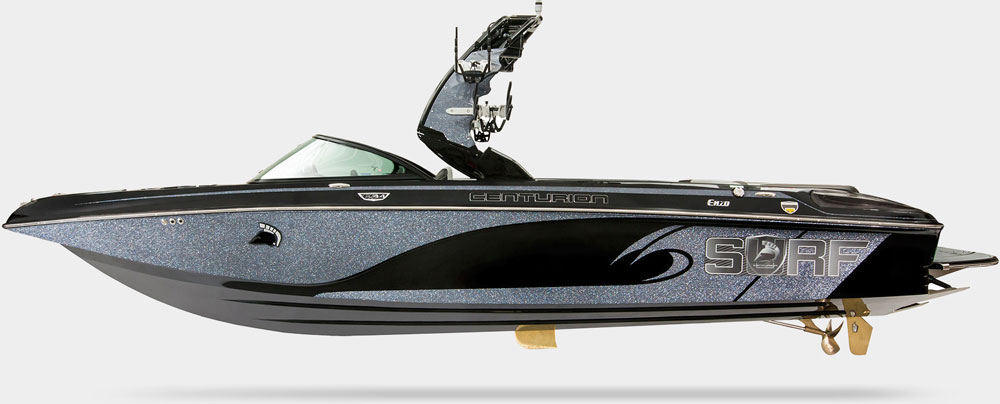
V drives allow a manufacturer to mount the engine far aft, but still utilize shafts that exit the hull bottom.
V Drives
- V drives allow for the engine to be located far aft, yet face forward, and still have shafts that exit the boat's bottom facing aft.
- This is advantageous since, being located all the way back near the boat's transom, they don't take up any cabin space.
- Since the engines aren't located forward as with traditional straight shaft drives, the weight distribution advantages of straight shaft inboards are largely forfeited.
- V drives are mostly seen on either mid-sized cabin cruisers and motoryachts (where an emphasis is placed on maximizing the cabin's interior volume,) or on wake surfing and wakeboarding boats (where locating the weight aft helps create a large wake as well as eliminate the need for a motorbox in the center of the cockpit, yet inboard propulsion is still preferred over a stern drive).

The surface drives on this Magnum 51 Bestia are clearly visible, and they help this boat break 70 MPH.
Surface Drives
- Sometimes called surface-piercing drives, these systems come through the transom close to the waterline and swing a propeller that’s only half-submerged when the boat is on plane. This reduces the propeller’s drag, resulting in a speed and efficiency increase. The most common is an Arneson drive.
- Surface drives are usually found on extremely expensive performance-oriented dayboats (like the Magnum 51 Bestia, or the Revolver 42).
- Some, but not all, surface drives are articulating. Some others require a rudder. Handling for either tends to be difficult at low speeds, and handling in reverse is particularly problematic.
- Draft is significantly reduced, as compared to other propeller-driven propulsion systems.
- Surface drives are designed to operate with half the propeller(s) out of the water, but at pre-planing speeds, the propeller(s) are fully submerged. As a result, some boats with surface drives have a very difficult time transitioning from pre-planing speeds to planing speeds.
Jet Drives
- Jet drives utilize a water impeller and nozzle to create thrust, instead of swinging a propeller. Jets are favored by some people on small runabouts since they eliminate all the dangers associated with propellers.
- They may be utilized on larger motorboats where draft is a serious consideration; unlike most other drive systems they require water no deeper than what is required to float the hull.
- Jets aren’t as efficient as propellers through most of the power-band, and although the difference often slims as you get closer and closer to top-end, at most reasonable cruising speeds and certainly at slower speeds, MPG will suffer as compared to propeller-driven boats.
- Handling a jet drive, which steers with thrust directed by the nozzle and (usually) a “bucket” that swings down over it to redirect thrust, takes some getting used to. There will be an adjustment period for boaters who are accustomed to other systems.
For direct comparisons between these different drive systems, read Outboards, Inboards, Pod Drives, Stern Drives, and Jets: Which is the Best?
For a direct comparison between jet, inboard, and pod propulsion in an identical boat, watch:
Hunt Harrier 36 Jet Drive: Video Boat Review
Hunt Harrier 36 Shaft Drive: Video Boat Review
and
Hunt Harrier 36 IPS: Video Boat Review
Whew! That’s quite a bit to digest, isn’t it? But motorboats aren't much fun without the motor, so understanding the high and low points of each type of boat engine and drive system is important. What’s even more important? Finding the system that’s best matched to your needs—so you have even more fun out on the water.
